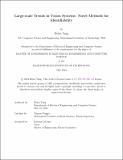Large-scale Trends in Vision Systems: Novel Methods for Identifiability
Author(s)
Yang, Helen
DownloadThesis PDF (19.85Mb)
Advisor
Poggio, Tomaso
Terms of use
Metadata
Show full item recordAbstract
While the analogy between artificial neural networks (ANNs) and the brain have been well validated in past work, one question without a clear answer is—what causes an ANN to be more or less brain-like? A better understanding of this may lead to the discovery and implementation of more performant and human-like AI systems. However, despite ANNs having been proposed as models of primate visual systems, the success in predicting both neural and behavioral responses of primates by ANNs has not been without contention. Increasing architectural and dataset sizes bring forth concerns of black boxes (artificial systems) explaining other black boxes (human intelligence), leading to our level of understanding of the relationship between artificial and biological visual systems hitting a wall. In addition, there is increasing empirical evidence that the representations learned by artificial vision systems are convergent: artificial vision systems trained on large datasets tend to learn similar representations despite having numerous differences in architecture and training. This lack of identifiability presents a challenge to comparison pipelines commonly used to validate artificial vision systems as models of biological vision—if two artificial vision systems with different architectures have convergent representations, we are limited in our ability to reason about the structural properties of an individual artificial vision system and determine which system provides a better model of the brain. In light of these issues, we provide an analysis of current frameworks for measuring artificial and biological visual system similarity and propose a novel approach toward improving identifiability between artificial vision systems via contrastive stimuli. We show that our approach offers better identifiability between artificial vision systems compared to standard benchmarks.
Date issued
2024-05Department
Massachusetts Institute of Technology. Department of Electrical Engineering and Computer SciencePublisher
Massachusetts Institute of Technology